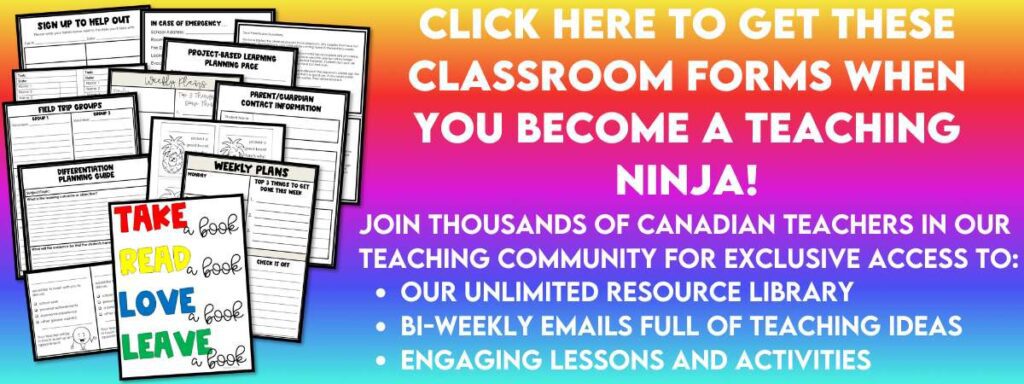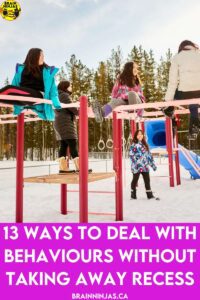
Fortunately, we have worked at schools with administrations who also don’t believe in taking away recess from students who act out in class. Sometimes, it feels like our hands are tied when it comes to dealing with student behaviour, but we have a few strategies that go beyond “building a relationship” to help get you through it. Come read our ideas so you don’t have to take away recess.
Get to the Root of the Problem
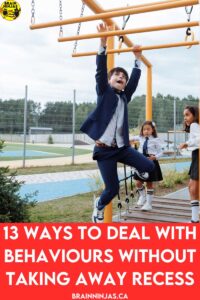
It is impossible to address poor behaviour without understanding why it is happening. Honestly, sometimes, it is poor classroom management. If you think this might be your problem, please read How to Make Students Listen Without Yelling.
Kids aren’t bad just because they want to be bad. There is always something at the heart of it. Don’t worry; we’re not going to tell you that all your problems come down to relationships. Sometimes, kids are just bad at controlling their behaviour. There is definitely a trend of behaviour that is getting worse and worse (and even the parents are seeing it). Some of this comes down to societal changes, the villainization of teachers, and the trauma of the pandemic. Some of it was already there and was just made worse by world events.
Generally, according to Linda Albert’s work, there are four main reasons students act out:
- fear of failure
- attention seeking
- needs not being met
- revenge seeking (or power seeking)
So, it is important to figure out what is driving the student behaviour so you can help minimize it. Taking away recess is the one method of punishment that we have learned never works. Often, students who need the brain break of recess are the ones who have their recess taken away. These kids need to move, wiggle, and get it out of their system. They need to talk to their friends, yell, and scream. They need to have a moment away from you (and yes, you need the break from them).
To find out what drives misbehaviour in students, you need to be a detective. Sometimes, asking previous teachers what worked or what didn’t can save you a bit of time. Be careful to talk about the behaviours and the solutions as opposed to just complaining about the student because that isn’t productive. Read their files. Talk to the families. Talk to the student directly.
Argue the Benefits of Recess
Another issue is that some schools don’t allow teachers to use their professional judgment to determine how the instructional time is spent. There are multiple articles on Google Scholar that point to the benefits of recess and unstructured playtime.
Generally, these point to three main benefits:
- Physical Activity: Recess allows students to engage in physical exercise, promoting healthy growth and development, improving fitness levels, and reducing sedentary behaviour.
- Social Interaction: Recess provides opportunities for students to interact with peers, develop social skills, build friendships, and learn important communication and conflict-resolution skills.
- Cognitive Benefits: Breaks from academic instruction during recess can enhance cognitive functioning, attention, and concentration, leading to improved academic performance.
Keep advocating! If that doesn’t work, consider a change of schools or boards.
Offer Extra Recess
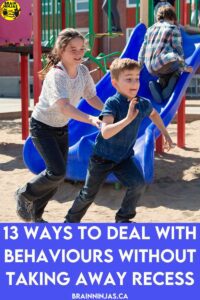
Instead of taking away a recess, incentivize your class to earn more recess. Make the student or students who have difficulty become the hero. Instead of drawing attention to the bad behaviour, negotiate a reasonable amount of time/amount of work/ or time without (bad behaviour) to earn the class a free recess. You can add a few minutes to recess (taking them outside early is an easy way to add some time). Explain that the student or students managed to earn some extra recess time in a secret mission, so be sure to thank them for their hard work.
Offer the secret mission to other students (not just the ones who misbehave or don’t misbehave). Make it a challenge for the class to start working together over time.
Earn Extra Gym Class
Work out a deal with another teacher to send a few of your students to join their gym class. We once worked out a deal with another teacher for them to take 19 of our students to play a game outside during recess, and we kept 8 students who could not get their behaviour under control. Nothing was announced. We just called the 19 students up and then joined the class as they walked by. Some of our students asked where they were going, and we didn’t answer until everyone returned. There were several students who had been left behind who were never a problem again. This didn’t work for everyone, but it definitely worked for most.
Take advantage of the gym time that might be available when other classes are out of the school on field trips. Take your class outside for some extra movement.
Avoid taking away physical education for the whole class. That’s just another way for the problem behaviour to be used for revenge.
Reflection Corner
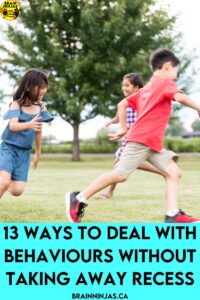
Set up a designated “reflection corner” in the classroom where students can take a few minutes to calm down. They can reflect on their behaviour and think about how they can make better choices. Provide reflection prompts or journals to encourage self-awareness and accountability.
This will not work for students who need to move, but it can be beneficial to students who just need a calm place to regulate their emotions.
Cool-Down Activities
Offer calming activities such as deep breathing exercises, mindfulness exercises, or yoga poses to help students manage their emotions and regain focus. These activities can be done individually or as a whole class. We use these types of activities after gym classes, recess breaks, or loud activities like group work.
Peer Mediation
Implement a peer mediation program where students are trained to resolve conflicts and disagreements among their peers constructively and respectfully. Empowering students to take an active role in conflict resolution promotes empathy, communication skills, and positive relationships.
Students will need plenty of direction to get this started. They will need to have strategies for dealing with situations, and the students struggling with behaviour may have difficulty buying in. But, if you have the right group of students, this can save you lots of time mediating situations between students.
Positive Reinforcement
Emphasize positive reinforcement by acknowledging and celebrating students’ good behaviour and achievements. These do not need to be physical items to reward students. Sometimes, your undivided attention is enough to start making ground. Call home, write emails, or send the student to the office for good things. Change the narrative.
Classroom Community Building
Dedicate time to building a positive classroom community through team-building activities, cooperative learning projects, and group discussions. Focus on fostering a sense of belonging, mutual respect, and support among students.
We have several different activities that we’ve designed to help students build community and learn to work together.
Classroom Community Unit for Grades 3-6 is in our TpT Store ($USD) or our BN Shop ($CAN).
Group Roles and Processes Unit (Learning to work in groups) for Grades 3-6 is in our TpT Store ($USD) or our BN Shop ($CAN).
Interest-Based Activities
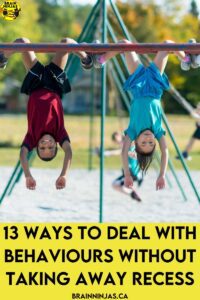
Offer students a choice of interest-based activities during designated free time, such as drawing, reading, board games, or puzzles. Allowing students to pursue activities they enjoy promotes engagement, autonomy, and intrinsic motivation.
Let your students share their passions. They could present their hobbies, teach the class something, or explain something they are interested in. This appeals to students who are attention-seeking, but it is a positive way to give attention.
Use these appointment cards to meet with students to discuss their interests. The appointment cards can be found in our Resource Library, along with many other general classroom forms to help you organize your classroom. Or, we’ll send a copy directly to your inbox when you sign up for our mailing list.
Community Service Projects
Engage students in meaningful community service projects within the school or local community. Collaborating on projects such as organizing a food drive, beautifying the school grounds, or writing letters to nursing home residents fosters empathy, teamwork, and a sense of responsibility.
Encourage your students to be involved in the community based on their own interests and passions. Have them brainstorm ideas together and then choose something they will be proud of.
Classroom Meetings
Hold short meetings to address conflicts or behavioural issues in an inclusive manner. Provide a safe space for students to express their feelings, share perspectives, and work towards resolution with support from their peers and the teacher. It takes practice to have students learn to communicate and listen.
Mindfulness Breaks
Incorporate brief mindfulness breaks throughout the day to help students refocus their attention and manage stress. This could be as simple as standing up and stretching occasionally. It could be reading to your students. Do some deep breathing.
Encourage Good Nutrition and Hydration
Ask students to look at what they are eating and whether they notice if certain foods help them focus or cause problems with focus. Avoid calling foods “good or bad,” but ask families to do their best to avoid too much sugar or foods that cause students to feel unwell. Remember that many families are doing their best, so avoid being judgmental.
We allow students to eat occasionally in class. Before allowing this, we discuss the types of food that would be acceptable so that no one is having buffet service at their desk. We also talk about what a quick snack is (a few bites of a granola bar) and what it is not (a whole sandwich). Students learn to pick something and eat without it interfering with lessons or getting their work done.
Students need water to function properly, and this will also mean bathroom breaks. We allow water bottles that can be sealed shut (no straws). Students can keep them on or in their desks most of the time, but we do have a rule about placing them on a nearby shelf or table when we are working with computers or art projects to avoid spilling. Students are only allowed water in their bottles, so if it spills, it is an easy clean-up. We allow students to bring their bottles to gym class and fill them in the fountains throughout the day.
While there are a few more bathroom breaks, overall, it’s an improvement. We find that by meeting these basic needs, many little behaviour issues go away.
What Else Have You Tried?
We have these blog posts that you might find helpful.
- How to Set the Noise Level in Your Classroom
- How to Chuck the Classroom Management Charts
- 3 Ways to Support Introverts in Your Classroom
- How to Create a Sense of Agency in the Classroom
What are some of the ways you discipline or reward your students without taking away recess? We’d love to hear about them in the comments below.

